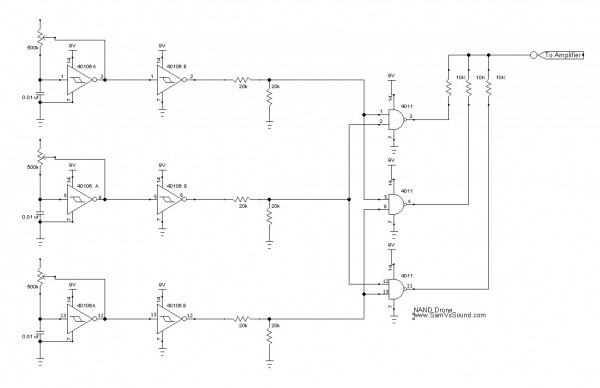| Author |
Message |
Dr. K
Joined: Jan 15, 2020
Posts: 52
Location: wisconsin
|
 Posted: Fri Apr 04, 2025 3:49 pm Post subject:
Using a 40106 as a unity gain buffer Posted: Fri Apr 04, 2025 3:49 pm Post subject:
Using a 40106 as a unity gain buffer |
  |
|
I finally broke down an picked up an oscilloscope. Trying to trouble shoot and tweak circuits without one is becoming a joke.
I'm planning out some VCO circuits (just recieved my kit for a Baby 8--the heart and soul of the whole project), and hoping to refine how to run several oscillator voltage controls with one sequencer.
My original plan was to use unity gain op-amp buffers, to decouple the CVs from each other. Then, each VCO would essentially be operating totallyl independently.
But I stumbled across something on SamvsSound, with his 40106-->NAND drone. In the schematic, he's using the 40106 both as the oscillator, and then as a buffer.
I have a half baked idea about unity gain op amp buffers, but have never heard of the 40106 being used as one. Can someone shed light on that? When you could or could not use a 40106 as a buffer? (I want to buffer the CV coming out of the sequencer, before driving the CVs of the oscillators.
Thanks so much for help with all the dumb questions. I've been reading as much as I can find, trying to gain a better understanding.
| Description: |
|
| Filesize: |
62.63 KB |
| Viewed: |
17 Time(s) |
| This image has been reduced to fit the page. Click on it to enlarge. |

|
|
|
|
Back to top
|
|
 |
blue hell
Site Admin

Joined: Apr 03, 2004
Posts: 24391
Location: The Netherlands, Enschede
Audio files: 296
G2 patch files: 320
|
 Posted: Fri Apr 04, 2025 4:28 pm Post subject: Posted: Fri Apr 04, 2025 4:28 pm Post subject:
|
  |
|
Not seeing the flashlight emoti-thingie .. but there is ...  .. <plop> lights on .. <plop> lights on 
They are not unity gain buffers here, but act like square-up shapers and they will isolate the oscillators from the outputs.
You can however make them behave as buffers by applying feedback ... that would still add some distortion and probably not not be completly unity gain - but way more analog - and useful.
For the circuit above it does not matter though - the oscillators make a square wave like output anyway ..so it will not hurt to square them up.
I hope that helped?
_________________
Jan
also .. could someone please turn down the thermostat a bit.
 |
|
|
Back to top
|
|
 |
Dr. K
Joined: Jan 15, 2020
Posts: 52
Location: wisconsin
|
 Posted: Fri Apr 04, 2025 4:43 pm Post subject: Posted: Fri Apr 04, 2025 4:43 pm Post subject:
|
  |
|
That does help. I guess I'm wondering, I hear a lot of things mentioning "loading" a chip--if I take a CV out of it, that it can load the output and inadvertently change the frequency.
I'm hoping to run a number of VCOs from 1 control voltage source ( but have the control voltages on a pot, so I can adjust the VCOs independently). It seemed like an op-amp would be the way to do it--to get the voltage out that you put in, but also provide a charge sink and fully isolate the oscillators from each other.
I'm planning to spend some quality breadboard time with my new o-scope. I'm just trying to think of intelligent options to look into. |
|
|
Back to top
|
|
 |
blue hell
Site Admin

Joined: Apr 03, 2004
Posts: 24391
Location: The Netherlands, Enschede
Audio files: 296
G2 patch files: 320
|
 Posted: Fri Apr 04, 2025 5:16 pm Post subject: Posted: Fri Apr 04, 2025 5:16 pm Post subject:
|
  |
|
Yeah like when you talk to one person or to two instead, and must distribute your energy.
In linear electronics you can calculate what happens and you really just need a couple of laws ..
Like Ohm's V=IR and power is handy .. p=VI and the Kirchhof things .. of sum of volages in a cirkle is zero .. and the other .. the total amount of cueent gong in is the same as what goes out -- https://en.wikipedia.org/wiki/Kirchhoff%27s_circuit_laws.
For alternating current and capacitors or coils it gets a bit more involved ..with complex math, but the idea still is the same .. just a handfulof ideas that are not too difficult .. and combine those likeina puzzle 
For active or non-linear elements there are a couple more rules of course .. but experience helps a lot .. so getting a scope for looking at what happens is a great idea ..even when it will take a bit of time to get used to the scope 
_________________
Jan
also .. could someone please turn down the thermostat a bit.
 |
|
|
Back to top
|
|
 |
Cynosure
Site Admin

Joined: Dec 11, 2010
Posts: 998
Location: Toronto, Ontario - Canada
Audio files: 82
|
 Posted: Fri Apr 04, 2025 7:13 pm Post subject: Posted: Fri Apr 04, 2025 7:13 pm Post subject:
|
  |
|
By "loading the chip" you might be referring to drawing high current from it. A resistor can be used on the output to limit the current if that is an issue.
I always use a second inverter on my 40106 oscillators as a buffer like in that schematic. It prevents the oscillator circuit from interacting with anything further down the line. As Jan said, it's a squarewave anyway, so just an inverter work fine in that application.
I don't know the reason why, but I was told that 4069 inverters work better as opamps. They sound nice when overdriven too (just protect the inputs with schotkey diodes if you intend to overdrive them).
_________________
JacobWatters.com |
|
|
Back to top
|
|
 |
blue hell
Site Admin

Joined: Apr 03, 2004
Posts: 24391
Location: The Netherlands, Enschede
Audio files: 296
G2 patch files: 320
|
 Posted: Fri Apr 04, 2025 7:27 pm Post subject: Posted: Fri Apr 04, 2025 7:27 pm Post subject:
|
  |
|
| Cynosure wrote: | | [...]I was told that 4069 inverters work better as opamps. |
O I can mansplain .. cool 
Yes, they will - as they do not have the internal positive feedback that the 40106 has ..
you can see it in their schematics as the hysteresisis symbol .. the 106 squares it up more than the 69 .. the 69 will be more linear.
_________________
Jan
also .. could someone please turn down the thermostat a bit.
 |
|
|
Back to top
|
|
 |
Cynosure
Site Admin

Joined: Dec 11, 2010
Posts: 998
Location: Toronto, Ontario - Canada
Audio files: 82
|
 Posted: Mon Apr 07, 2025 6:28 am Post subject: Posted: Mon Apr 07, 2025 6:28 am Post subject:
|
  |
|
| blue hell wrote: | O I can mansplain .. cool  |
Thank you for the explanation 
_________________
JacobWatters.com |
|
|
Back to top
|
|
 |
|

